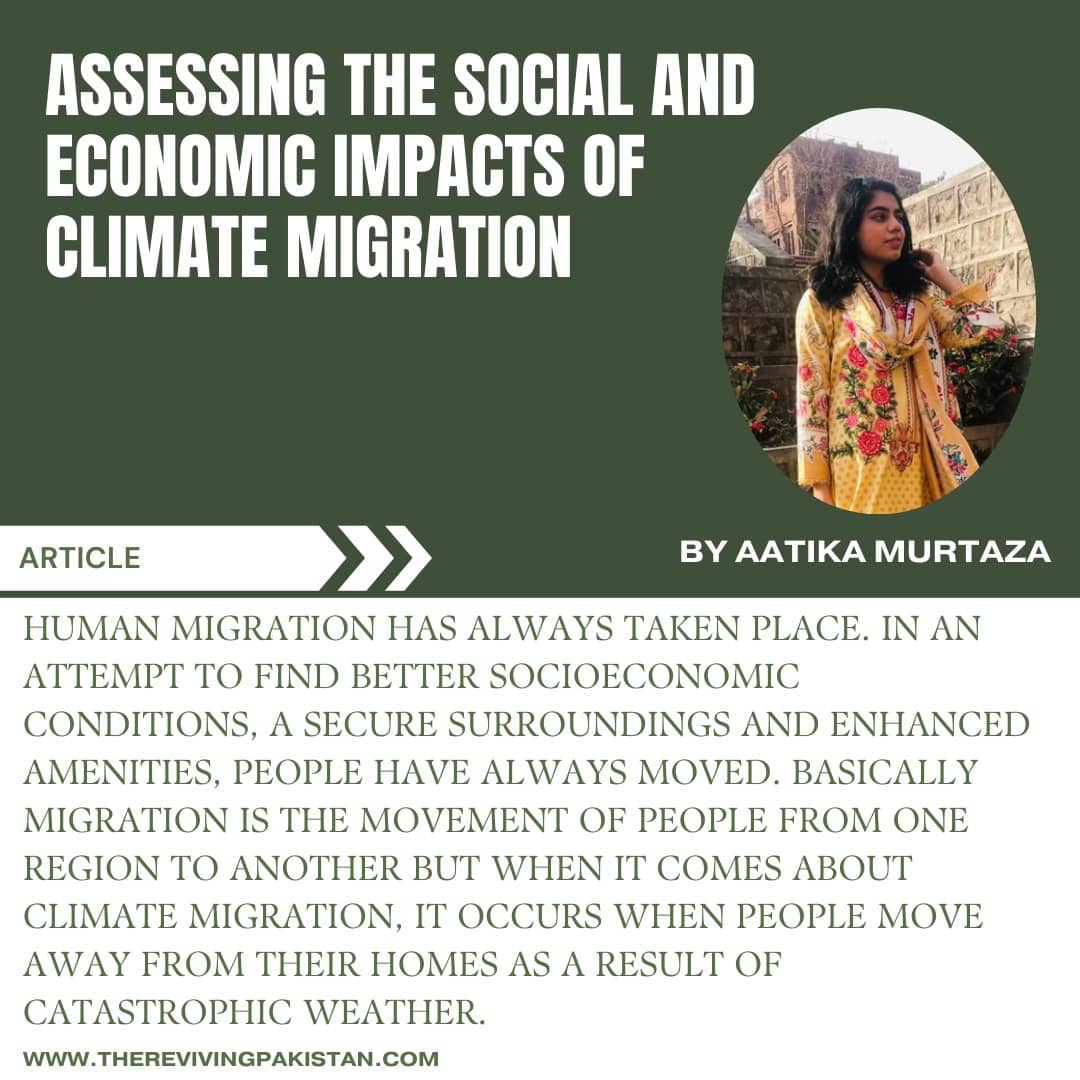About the Author(s)

Aatika Murtaza
Author has completed her bachelor’s degree in Environmental Science from International Islamic University, Islamabad. She is currently pursuing her master’s degree in Environmental Science from the National University of Sciences and Technology, Islamabad.
Human migration has always taken place. In an attempt to find better socioeconomic conditions, a secure surroundings and enhanced amenities, people have always moved. Basically migration is the movement of people from one region to another but when it comes about climate migration, it occurs when people move away from their homes as a result of catastrophic weather conditions such as floods, heat waves, droughts and wildfire, as well as slow moving climate issues like rising sea level and increasing water stress. Climate persuade migration is increasing at very alarming rate not only within country’s border but also cross border as the world is not being able to reduce greenhouse gases emissions (GHG) and to tackle other climate change induced disasters.
According to Internal Displacement Monitoring Centre (IDMC) report, about 75.9 million displacement were registered till the end of 2023. The World Bank also projected that if the concerted climate action is not taken then there would be approximately 216 million people could become internal climate migrant by 2050 across the globe. Climate stressors such as changing rainfall pattern, heavy flooding and rising sea level, increasing temperature, more frequent cyclones, desertification, air pollution, vulnerable geographies, forest fires after drought and low adaptive capacities are the main factors that endanger ecological resilience and make an area inhabitable that results in climate migration. Climate change impacts are mainly hitting low and middle developing countries like Pakistan, Bangladesh, Kenya, Kiribati and Somalia etc. displacing millions of people from their homes to save their livelihood. This migration process cause many social, economic and cultural consequences for both host societies and for migrants especially for low-income developing countries such as unemployment, poverty, difficulty in accessing resources such as food, energy and water.
Climate migration may have both short-term and long-term social consequences for both host communities and for migrants. Congestion and pressure on resources are the short term challenges but long term provocation include cultural shocks, deterioration of health conditions, cutting of their connections with traditions to adopt new way of life in host area, social tensions may arise between migrants and host communities that would lead to potential conflict, crime and violence as they would compete for minute resources.
For instance, historic flooding of year 2022 in Pakistan damaged water systems in affected areas forcing about 5.4 million people including 2.5 million children to rely on contaminated water from ponds and wells that results in water borne diseases due to lack of access to safe drinking water. It is also estimated that around 3.5 million children especially girls are at risk of permanently dropping out of school as thousands of schools and health facilities were destroyed in flooding. Climate induced migration mainly impact women damaging their emotional health and wellbeing as domestic workload increases, and earning opportunities lost. Similarly, in Northeastern Bangladesh record breaking floods from Barak and Kushiyara rivers in May 2022 hits Sylhet and Sunamganj districts cause disruption of 650 educational institutions in Sylhet, 500 villages were damaged by floods and there was shortage of clean water in flood affected areas. Access to food became major problem for migrants as the assistance received from the government was insufficient.
Flooding also worsen there mental health due to lack of medical services. Likewise in Somalia the 2nd most vulnerable country to climate change, three successive failed rainy seasons had led to devastating drought that was started in 2021 displaced approximately 755,000 people as there was no water and food left in their villages. Displaced women and children was on high risk as 30% children became dropped out of school and young girls were forced to get marry due to increased risk of sexual violence and harassment. Outbreak of diseases e.g. cholera increased due to contaminated water, lack of proper waste disposal, sanitation and hygiene facilities. Areas affected by climate induced migration require several efforts to reduce social impacts by taking effective measures such as providing sustainable infrastructure in migrant receiving cities, awareness campaigns and by strengthening national polices and strategies.
Despite having a large number of social impacts there are also many economic consequences for source region and for destination region, and as a whole on country’s economy. Loss of households, livestock’s, incomes, assets, rising food prices, disease outbreaks, deep poverty, damage and losses in agriculture sector, and increased number of unemployment are the some main factors that cause low quality life and disrupt economic conditions in a certain area.
For instance, in Pakistan the 2022 flooding had inflicted more than $30 billion in damages and economic losses. Flood particularly affected the poorest and most vulnerable areas. Migration from flood affected areas to urban areas contributes to overcrowding in cities and end up marginal lands in the cities that were already prone to flood or other risks. Housing, agriculture, transportation, communication and livestock were the most suffered sectors especially in Sindh province. The floodwater washed away 2 million houses, killed 1.2 million livestock animal, 439 bridges were destroyed, more than 4 million acres of agricultural land was run down and damage 13,000 kilometers of roads. The national poverty rate increased by 3.7 to 4 % forcing approximately 9.1 million more people below poverty line. National emergency was declared as one-third of country was under the water and inflation rate raised to its peak level as there was shortage of food commodities and other services. As a direct impact of flood there is around 2.2 % loss in gross domestic product (GDP) of country for FY22. Given that global economies heavily depends upon climate sensitive sectors such as agriculture, it’s become need of time to promote adaptive capacities in vulnerable areas to reduce climate migration to prevent both social and economic damages.
Greater environmental pressures such as climate change are forcing millions of people to move from their homes which would result in conflict and instability in host communities. Sub-Saharan Africa, Latin Amercia and South Asia are the most vulnerable regions to climate change that leads to climate migration. It must be proactive in helping vulnerable regions to adapt to climate change by formulating different policies and adaptation strategies to reduce climate migration.
Different regions make policy responses according to specific challenges and circumstances of displacement. In response to devastating impacts of climate change, the government of Bangladesh established its National Strategy on the Management of Disaster and Climate Induced Internal Displacement in 2015. Likewise, Kenya has several polices related to climate migration but National Climate Change Response Strategy of 2010 and National Climate Change Action Plan of 2013 mainly address different aspects of climate change including climate migration.
At international level, the Sendai Framework 2015-2030 was adopted at the third UN World Conference on Disaster Risk Reduction in Sendai, Japan, on March 18, 2015. Over the next 15 years, it intends to significantly reduce catastrophic risk and losses to people’s lives, livelihood, and health, as well as to the economic, physical, social, cultural, and environmental assets of individuals, enterprises, communities and nations. After that the New York Declaration for migrants and Refugees was adopted on 19 September, 2016. It was the first United Nations declaration on migration. It includes the commitments such as protection of human rights of all migrants and refugees regardless of their status, prevention and response to sexual and gender based violence, support for those countries who are receiving a large number of refugees and migrants, development assistance to most affected countries and to strengthen the global governance of migration by bringing the International Organization for Migration into UN systems. It paved the ways for adaptation of Global Compact for Safe, Orderly and Regular Migration on December 10, 2018 by majority of United Nations member. It is a non-binding document that indicates commitment to global cooperation on migration while respecting nations’ sovereign rights to control how enter and remains on their territory. It offers a great chance to boost the contributions of migrants and movement to sustainable development, to solve the difficulties connected with today’s migration and to improve the governance of migration. There are several national and international legal frameworks that deal with concerns like migration, risk management, displacement and climate change but there is a lack of any legal document that specifically address the issue of climate injustice as well as violation of human rights.
It is concluded as physical impacts of climate change are making a large amount of migrations necessary at the global level. These migrations are posing many social and economic impacts not only for migrants but also put pressure on host communities. It is noted that although good economic conditions play a vital role to maintain livelihood but there are more social challenges that are faced by migrants and local societies such as discrimination, competition for employment and perilous living conditions. In order to address migration issue induced by climate change different countries make migration related national policy framework and there is also a great response at international level but data is often limited. Definitions and conceptual understanding of climate induced migration lacking.
Additional study, including scholarly analysis, is necessary to prove a connection between climate change and migration, to identify the underlying factors behind climate caused migration, as well as how it affects the most helpless. Although we cannot reserve climate change, but we can implement effective resilience strategies, fair water management, gendered disaster relief polices, and social protection measures, such as those that assist in expending the source of income for women who are negatively impacted by climate change. Each and every climate migrant should have the right to travel with dignity, not simply toward a dazzling city but also towards a secure future.

